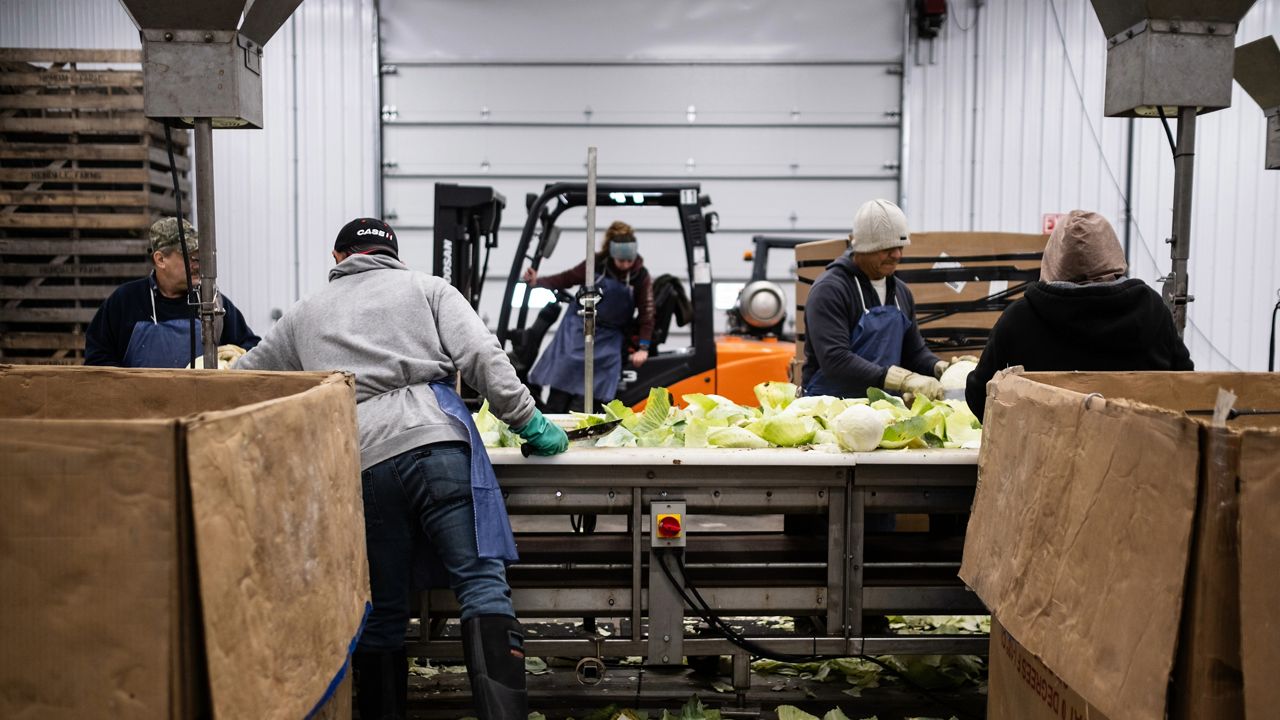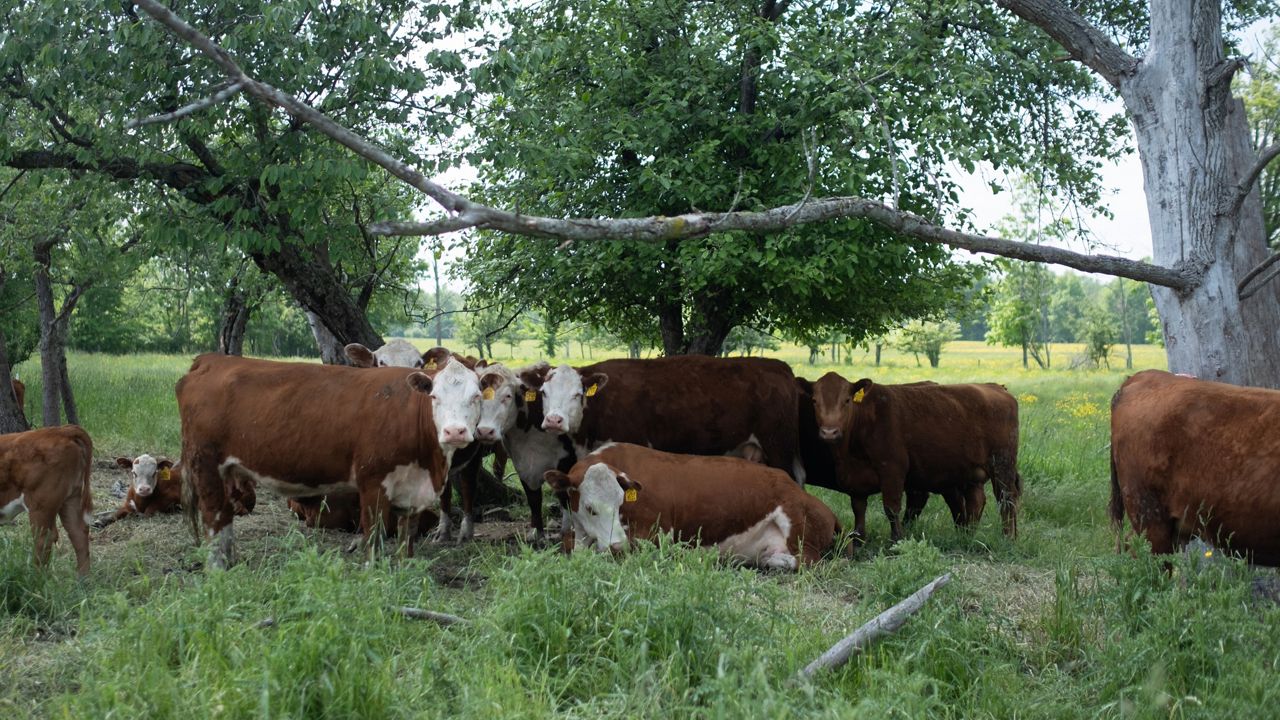New overtime threshold rules for New York farmworkers have caused confusion for both owners and their staff, resulting in reduced working hours, farmers said in recent interviews.
Farmworkers say they are upset with changes that went into effect Jan. 1 that moved the overtime threshold in New York state down from 60 to 56 hours. The rule means farmers have to start paying overtime after 56 hours worked. Farmers are eligible to apply for a tax credit to offset what they pay their workers, but three upstate farmers said they are still cutting hours.
That has led to confusion and anger over lost wages among workers, the farmers said.
A spokesperson for the New York State Department of Agriculture and Markets did not immediately return a request for comment.

Nestor Naranjo has worked at Hemdale Farms in Clifton Springs for 10 years, and before that, his parents both worked on the farm for more than 20 years when they moved from Mexico to the United States.
“With them, the hours they were working is the reason I’m here today. They were able to work many hours, get paid and bring me over here. It’s tough for a lot of employees here because they really only come here to get a better life than in Mexico,” Naranjo said.
His parents brought Naranjo and his brother to the U.S. in 2003.
“Many of the workers that work all those hours, they rarely see that money for themselves because they’re just sending it to Mexico,” he said.
The unpredictability of working in agriculture makes it difficult to stop doing a task when a worker hits 56 hours, Naranjo said. Due to his years of experience on the farm, he is often called back after hours if something goes wrong.

“I’m someone that if something happens at night, they’ll always call me, and I’ll come fix it. You work on the cows’ time so you can’t really put a time schedule on it,” he said.
The farm milks 1,600 cows and tends 3,000 acres of cabbage, corn, wheat and soybeans.
Naranjo said many of the workers are already thinking about getting another job because while their paycheck covers their own expenses, many send money back to their family members in their home countries.
“It’s tough because we’re all questioning whether we will have to get another job if they bring it down to 40 hours,” Naranjo said.
Hemdale Farms employs between 15 and 50 farmworkers depending on the time of year. Some are migrant seasonal workers, but others, like Naranjo, are permanent residents.

“On average, we’re at about 50 to 60 hours a week, but when we’re really busy, particularly with planting and harvest, it’s not uncommon to get up to 70 hours or more,” said Dale Hemminger, the owner of Hemdale Farms.
Hemminger said due to the weather conditions, some days are longer than others.
“We have to wait until it stops raining and dries up for a few days then we can plant, and we work quite long hours. It’s not uncommon to work 14 to 16 hours for a few days to get things back on schedule,” he said.
As part of the new law, New York state provides a tax credit for overtime costs farms incur between the threshold and 60 hours. But Hemminger said applying for that credit is going to be a process.

“My accountant tells me it’s a very cumbersome process, and the state hasn’t quite got it all figured out yet,” he said.
Over the next 10 years, the threshold will come down four hours each year until it reaches 40.
Hemminger said he has had to cut hours and his workers aren’t happy, and as they continue to go down, many will think about getting another part-time job at other farms.
“They’re disappointed that we are holding back to 56, and they’re already starting to ask us about what’s going to happen when we go down to 52 and then 48,” Hemminger said.
Hemminger is concerned that disease could spread between farms if workers opt to offset losses by working part-time elsewhere.
“We’re going to disrupt the biosecurity at the farms because they go from one place to another with their coveralls and boots,” Hemminger said.
Eric Hansen, a fourth-generation farmer who also grows cabbage in Ontario County, said his workers haven’t been happy with the reduction of hours he’s had to implement.
“They are here for a certain amount of time. They want to maximize the dollars they make, and how do you do that? You work more hours. If I were to tell them, there’s no work for the day, they’re mad. Or if I say they have to go home because they’re at 45 to 50 hours, they’re not happy,” Hansen said.
He is concerned that workers will move to another state to find work where they can earn more money.

“I’m nervous that the turnover rate will be higher simply because they know they can go to another state that doesn’t have these rules,” Hansen said.
Richard Stup, the director of Cornell’s Agricultural Workforce Program, said confusion around the overtime threshold for workers and farmers has been a catalyst for their partnership with the state.
“It’s really important for employers to understand the overtime tax credit that's available to make sure that they qualify for that and are receiving benefits that are helpful to them,” Stup said. “It’s also important for the employees to make sure that they’re getting as many hours as they want and that they’re able to earn as much as they would want to support their families.”
He hopes this is an opportunity to increase collaboration.
“We want to significantly increase what we’re doing with farm employees to help them understand regulations much more clearly,” Stup said.
Natasha Sutherland, a dairy farmer in Leroy, said she appreciates the work that Cornell’s Agricultural Workforce Program does but has concerns about the benefits of this partnership.
“Who are they going to be educating? The skilled staff we have been developing for years is exiting the state due to the overtime threshold handcuffing the wages us farm owners can offer,” she said.

Additionally, not all farms have the resources to file paperwork for tax credits, she said.
“Who has the time to fill out grant applications? Farms with resources. Struggling farms will not have the capacity with their staff or owners to jump through legislative hoops,” she said.
For the first week of January, Sutherland said they had 79 hours of overtime that they didn’t know how to cover.
“I’ve absolutely had to cut hours. On average, my guys have lost between five and six hours,” she said.
Hemminger said the implementation of this threshold is frightening for farmers and workers alike.
“We know how to work hard and know how to farm in this part of the country. Just give me a level playing field so my son and the team can be competitive and run a viable business,” he said.







